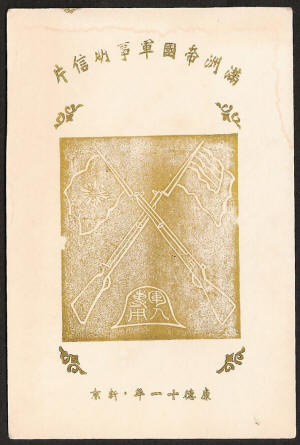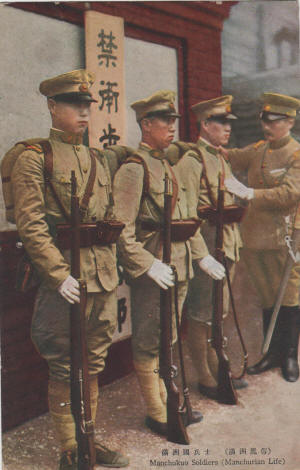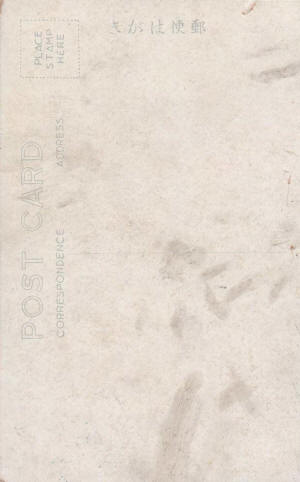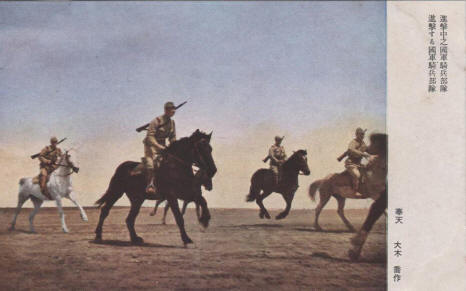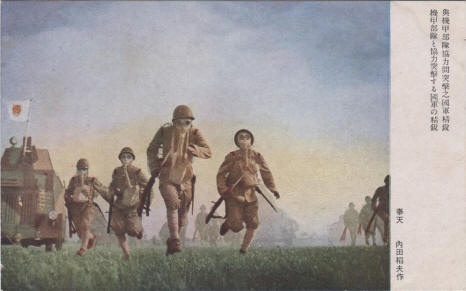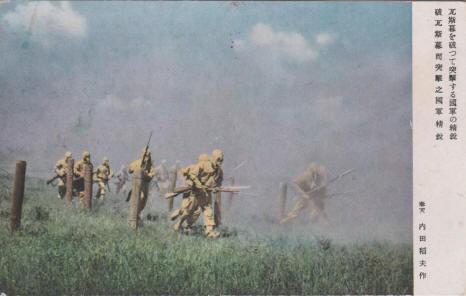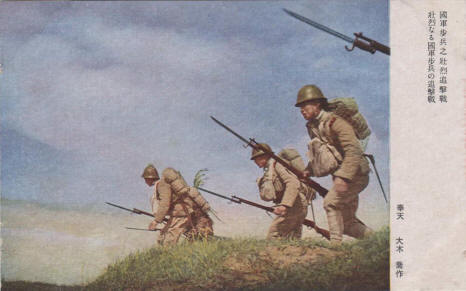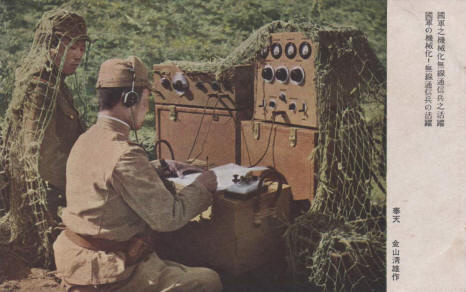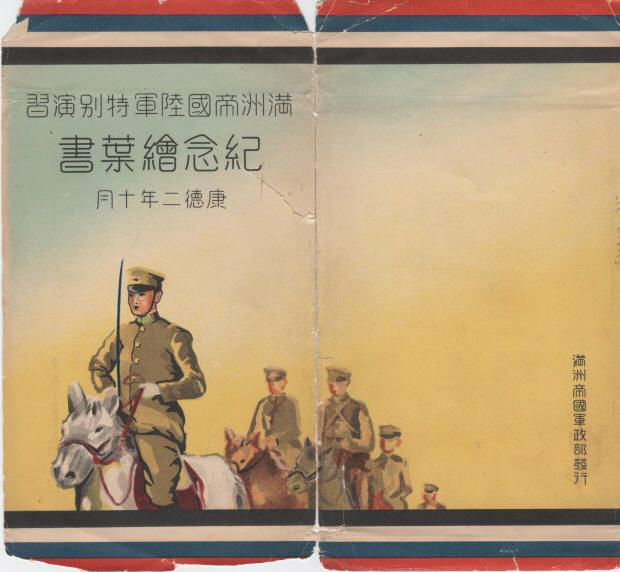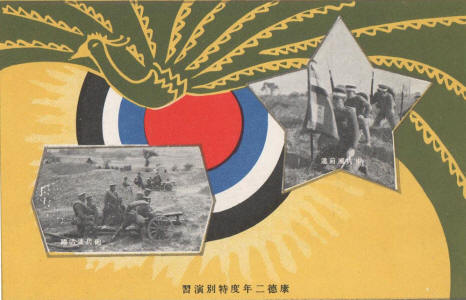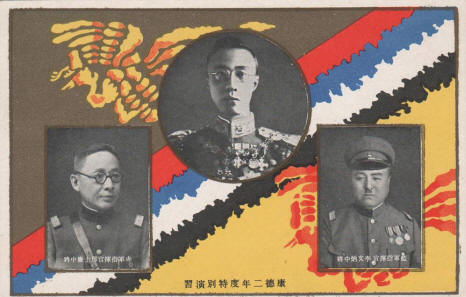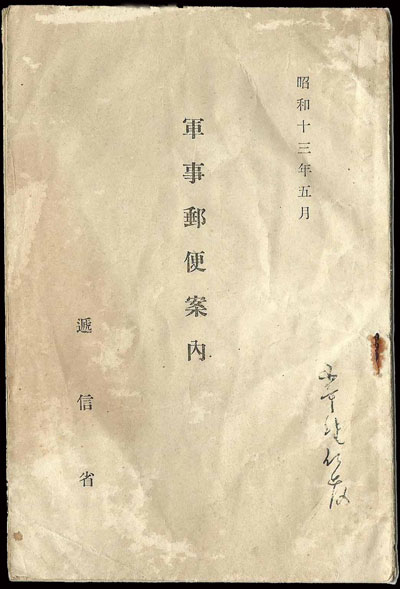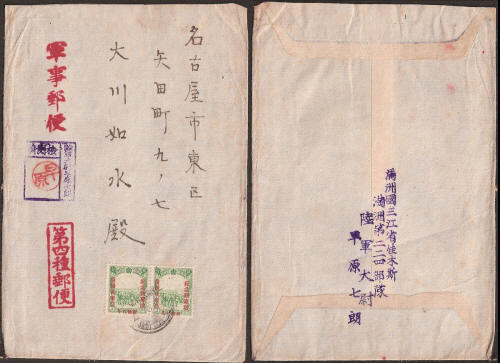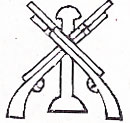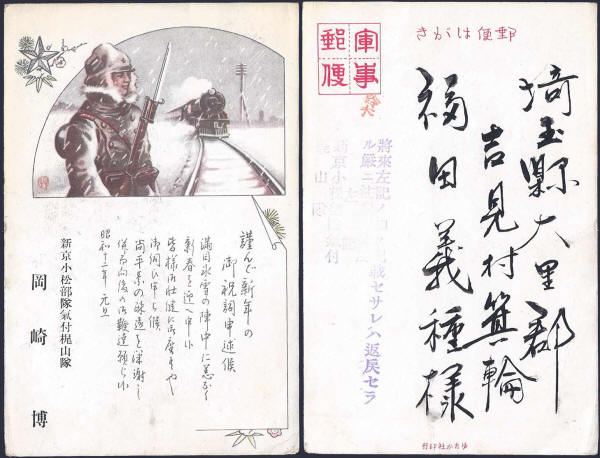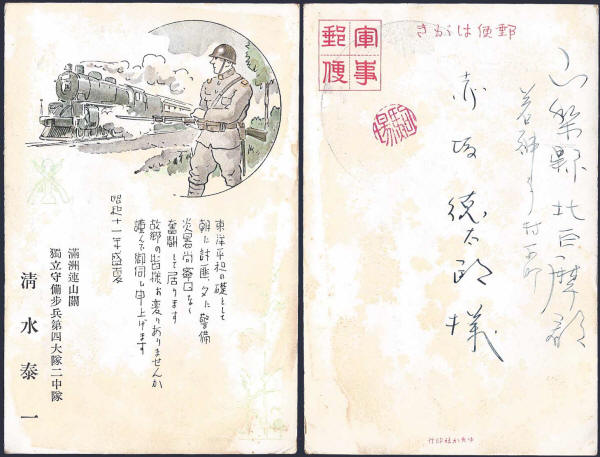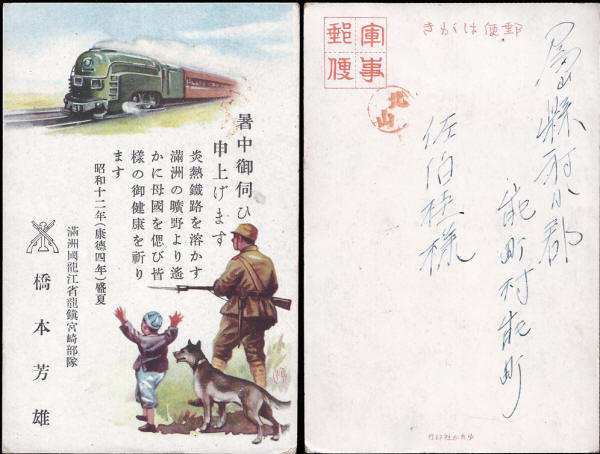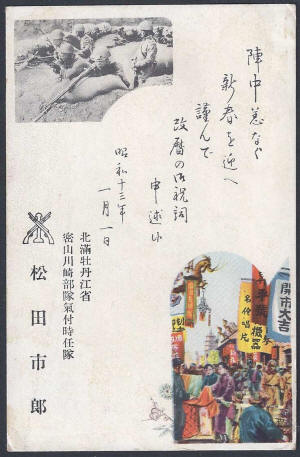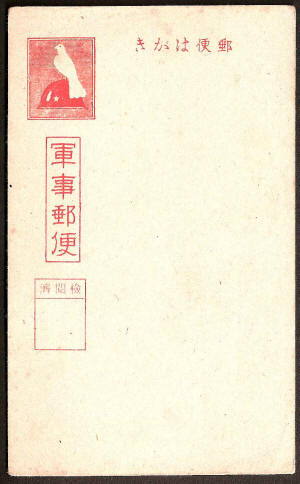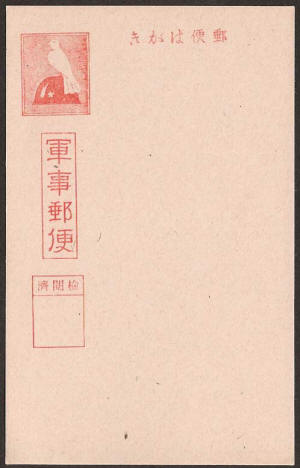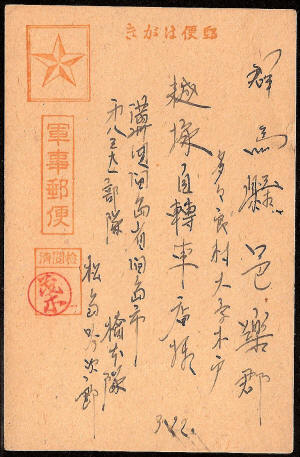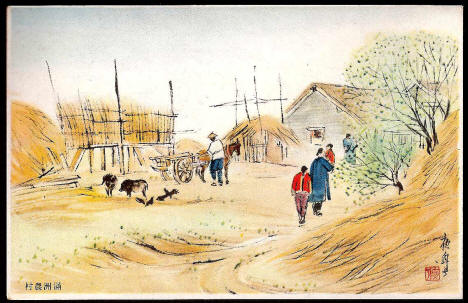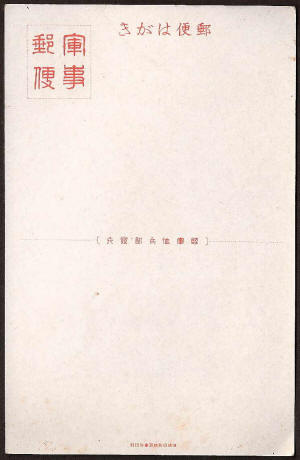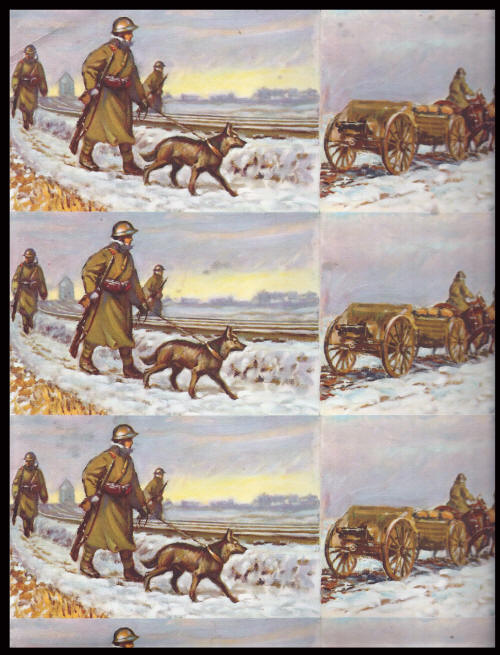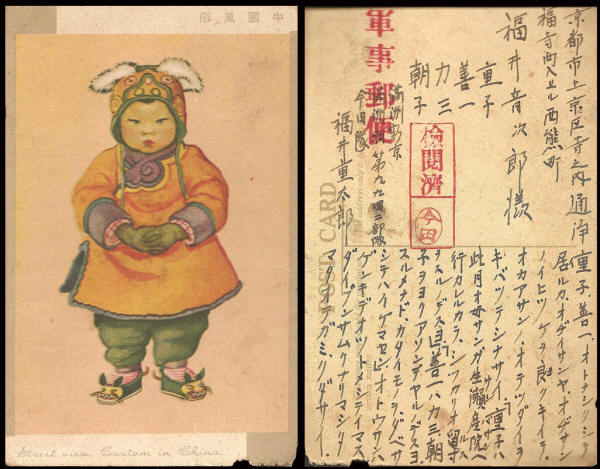 |
|||||
|
|
|||||
|
Manchukoan Military Mail I have been able to discover very little about the Military Mail system used by domestic troops in Manchukuo. The only example that ever seems to appear is the Military Postcard shown below, and this is a rarity. It is likely that the system used to address mail was based upon the Japanese model but so far I have found no evidence to support this. Please let me know if you have more information. The Manchukuo Official Military Postcard Shown above is the only official Military Postcard issued to the Manchukuo army. This card is something of a rarity indicating that issue date is likely to be some time late in 1944. The design is printed on off white, medium weight card, the front of which is smooth the reverse slightly textured and blank. The size is 86mm x 130mm, smaller than a standard postcard. The heading reads "Manchoukuo Military Post Card", on the helmet the seal script reads "Exclusive use of military personnel", the characters at the foot of the card read "Kangteh 11, Hsinking" (1944). Thanks go to Richard Arent for providing the translation. I have not seen a used example so the way in which it was used and the correct method of address is currently a mystery. If anyone reading this has a used copy please send me a scan.
Picture Postcards Featuring the Army of Manchukuo. Postcards showing the Manchukoan Army are very hard to find. The selection below comes from the fine specialist collection of Mr Richard Arent. Imperial Guard This postcard features soldiers of the Manchukuo Imperial Guard.
Picture Postcards Featuring the Army of Manchukuo. This is a group of five cards showing the Manchukuo Army in Action, they would have had an associated folder. The cards were issued by the Chih-an-bu (治安部) Zhě'ān Bu, this possibly translates as Public Security Dept or Peace Preservation Dept.. To see the reverse click here (the back reads made by Kwantung Army HQ). Manchoukuo cavalry unit advancing Highly efficient coordinated attack with armored unit and Manchoukuo army The National army attacking through a gas curtain Brave infantry of the Manshu army battling in pursuit Manchoukuo Army mechanization! Manchoukuo army wireless radio troops in action
October 1935 (Kangteh 2) Special Exercise Set A Series of three cards Showing the Army of Manchukuo on Manoeuvres. Produced by the "Manchou Tiguo Military Dept". To see the reverse click here. Folder reads - Manchou Tiguo Army Special Exercise. Commemorative Post Cards. Kangteh 2, October. Artillery in action - Infantry unit advancing Working outside the capital - On the banks of the Itung River L: Lt Gen Hsing Shih-lien, Commander Red Army - R: Lt Gen Li Wen-ping, Commander Blue Army (The colours relate to the exercise).
A Rare Manchukuo Naval Card This card shows a gunboat used to patrol rivers. This type of craft is typical of the small Manchukuo Navy. For heavier ships they had to rely on the Japanese Navy. The cancel dates this card to 20th October 1934.
Japanese Military Mail 軍事郵便 (Gunji Yūbin/Military Mail) For the full term of the existence of Manchukuo the country was occupied by Japanese troops. This meant that special provision needed to be made for military mail. The terms under which Military Mail was operated is shown in this special guide issued to civilians wishing to sent post to family members in the army overseas. I am not a specialist in Military Mail are but fortunately Neil Kaplan in Israel managed to find the mail guide shown below and Richard Arent in the USA has kindly translated it into English. It makes interesting reading.
To download a .pdf translation click here. For a list of Unit Code Names and Numbers (also supplied by Richard Arent) click here. Military Mail with added Postage Stamps This letter was sent in 1943 by a Japanese Officer, Army Captain Sakihara Shichirō - officers could post letters whereas ordinary soldiers had to make do with postcards. It was posted from Jiamusi, Manshū 224 Butai (Manshū 224 was the code for 10th Division Headquarters) to Nagoya, Higashi-ku (East Ward), Yada-chō 9-7. The envelope is stamped Military Post 軍事郵便 Gunji Yūbin (in red), Censored 検閲済 ken’etsuzumi (Top of purple box), Sakihara 早原 Shichirō 七朗 Captain 大尉 (Taii) (right side of purple box), Sakihara Red circular chop inside purple box also 4th class mail (lower red rectangle). In this instance the term 4th Class mail is important. It explains the use of the 2 x 2f postage stamps and shows why this letter was treated as "Printed Matter" it is also possible (although unlikely) that it contained Braille material. (My thanks to Richard Arent for the above explanation)
Japanese Military Postcards Japan provided a free postal service for soldiers stationed in Manchukuo from 13th November 1931. For enlisted men postcards were free, officers were allowed free postcards and letters. Many variations of cards were printed for this service, some of which appear below. The cards are distinguished by four large characters 軍事郵便 reading Military Post, either in a square shape, or aligned vertically. They will also usually have a box for a censors stamps with the characters 検閲 censored. Plain card could be hand stamped and used in the same way if stocks of pre-printed cards ran low. The cards were sent through branches of the South Manchurian Railway Zone Post Offices operating under the Kwantung Communications Bureau based in Dairen. The service was tightly controlled by the military due to a need for censorship. Railway Guard Garrisons
Railway Guard Logo This card was sent from the 連山關 Lien-shan-kuan (Lianshanguan) SMRZ Independent Garrison, addressed to Yamanashi, and censored. This card was sent from the Hsinking c/o Komatsu force, Kajiyama Unit to Saitama, Japan on 1st Jan 1937, it is a New Years greeting. 1937, This is a summer greeting card, the message reads "Allow me to give my Summer greeting from Manchukuo where the summer heat is almost melting the railway lines. Recalling the homeland, I wish everyone good health. From Yoshio Hashimoto, Manchukuo Miyazaki Unit." This card is dated 1st January 1938 and is New Years greeting send from the Kawasaki Unit, 密山 Mishan in Mudanjiang Province. Mishan is known to have had a Military Hospital but there are no records of the other Units based there. Various Japanese Military Cards
|
|||||
| Dove and Helmet design on cream card. | Dove and Helmet design on buff card. | ||||
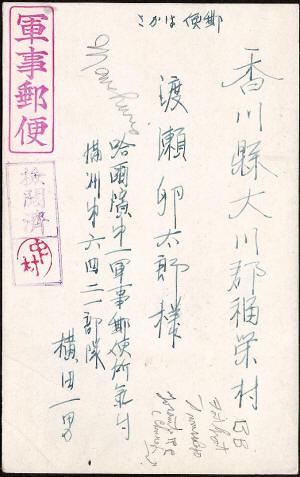 |
|||||
| Hand-stamped Card sent from Harbin | Army Star Design. This example was sent from 1 Air Signal Regiment, 3 Air Army at Chientao to Gumna. | ||||
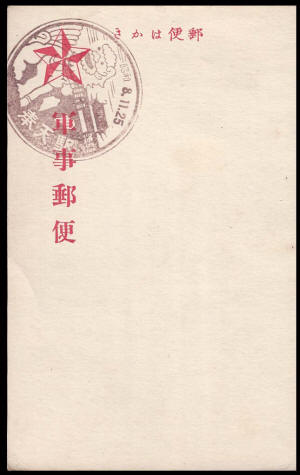 |
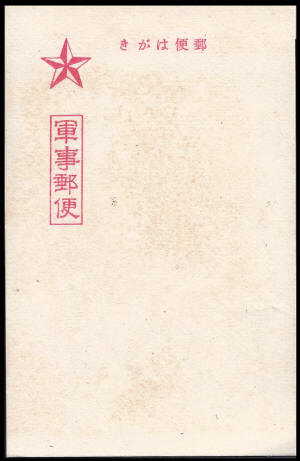 |
||||
| Army Star Design. Dateable due to the Mukden Station cachet to 25th November 1933. | Army Star Design. | ||||
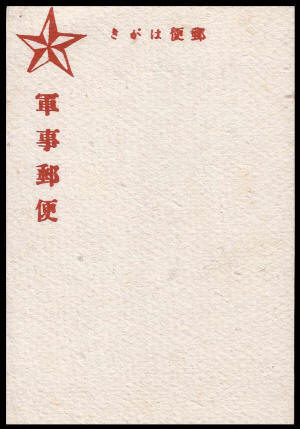 |
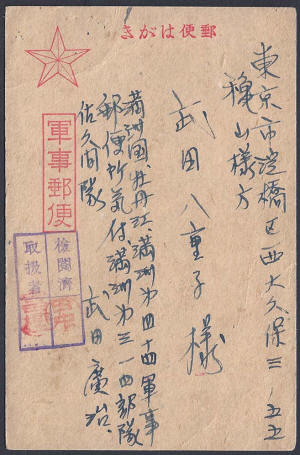 |
||||
| Army Star Design on thick paper. Perhaps locally produced and smaller than the standard size. | Army Star Design with censor chops sent to Tokyo. | ||||
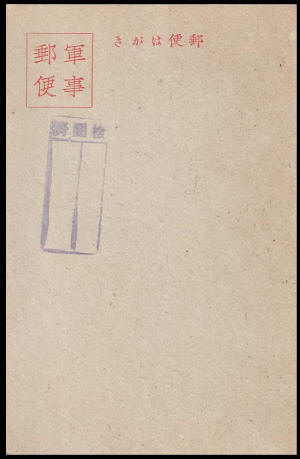 |
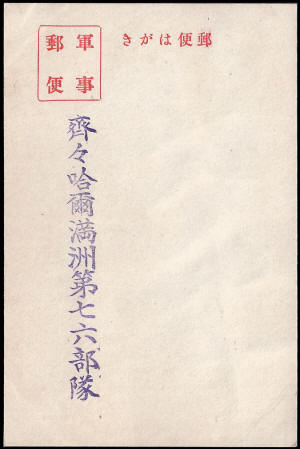 |
||||
| Plain box design with a censor box hand-stamp. |
Plain box design with a
"Qiqihar Manshu Dai 76 Butai"
hand-stamp.
(Manshu Unit 76 was the Kwantung
Army Field Ordnance Depot).
|
||||
|
|
|||||
| Japanese Military Envelopes | |||||
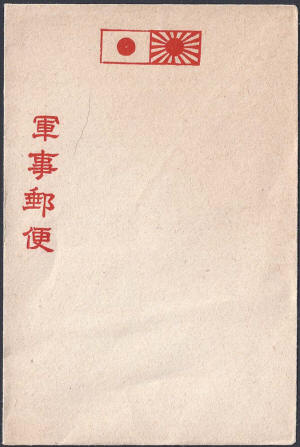 |
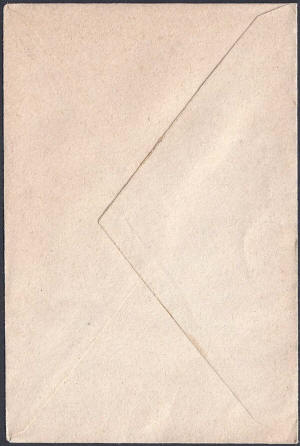 |
||||
| Military Envelope with an Imperial Japanese flag and a Japanese Army flag design. The date of this is unknown the army flag design was in use from 1870 to 1945 and used in overseas campaigns. | |||||
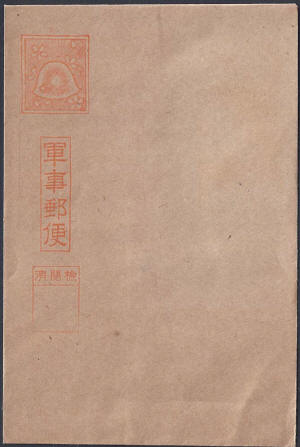 |
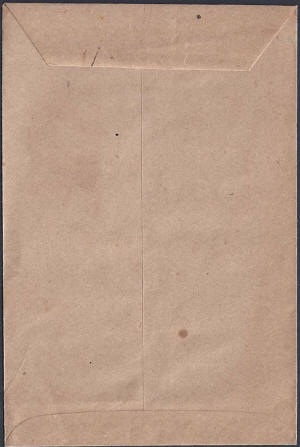 |
||||
| Military Envelope with a helmet design and a box for a censor chop. This probably dates to the late 1930's to early 40's. | |||||
|
|
|||||
| Picture Postcards | |||||
|
Above is the front and back of a range of pictorial postcards showing a selection of pastoral scenes. Date unknown. To see further cards from the set click here. |
|||||
|
Part of a rare uncut sheet of Military Propaganda Postcards known to have been issued prior to the formation of Manchukuo in 1932 although still in use at that time.. To see the reverse click here. |
|||||
| Part of an uncut sheet of postcards with a military theme but not for use by troops without a stamp. To see the reverse click here. | |||||
|
|
|||||
|
Postcard Designed by Elizabeth Keith |
|||||
|
This card entitled Street view, Custom in China is unsigned but the artwork was done by Miss Elizabeth Keith, born in Scotland, raised in England and spent some 20 years in the Far East creating a number of woodblock prints. Miss Keith probably never knew (let alone approved of) the Japanese Army plagiarizing her work with her signature removed. The signature can be seen on cards of the same design printed by Kelly and Walsh.
This example was sent to Kyoto from Hsinking by a member of Manchou Hane #9942 Butai, Imada Tai (Butai = unit, tai = a smaller unit; in this case the butai is a regiment and Imada Tai probably refers to his company with Imada being the surname of the commander). [Hane (wings) is the code name for the 2nd Air Army; 9942 the code number for the 6th Air Signal Regiment].
The card image and the interesting explanation was supplied by Richard Arent. |
|||||
|
|
|||||
|
|
|||||
|
|
|||||
|
|
|||||
|
|
|||||
